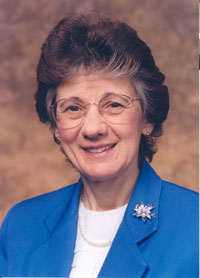2005-2006 Provost Lecture Series

The Cholera-Climate Paradigm for Science
in the Twenty-first Century:
Interdisciplinary, International and Complex
Thursday, October 27, 2005
10:30 a.m. to 12:00 p.m.
Hemisphere Room
Rita Colwell
Former head of NSF (1998-2004
Chairman of Canon US Life Sciences, Inc.
Distinguished University Professor at
University of Maryland at College Park and
Johns Hopkins University Bloomberg School of Public Health
Biographical Sketch
Dr. Rita Colwell is Chairman of Canon US Life Sciences, Inc. and Distinguished University Professor both at the University of Maryland at College Park and at Johns Hopkins University Bloomberg School of Public Health. Her interests are focused on global infectious diseases, water, and health, and she is currently developing an international network to address emerging infectious diseases and water issues, including safe drinking water for both the developed and developing world.
Dr. Colwell served as the 11th Director of the National Science Foundation, 1998-2004. In her capacity as NSF Director, she served as Co-chair of the Committee on Science of the National Science and Technology Council. One of her major interests include K-12 science and mathematics education, graduate science and engineering education and the increased participation of women and minorities in science and engineering.
Dr. Colwell has held many advisory positions in the U.S. Government, nonprofit science policy organizations, and private foundations, as well as in the international scientific research community. She is a nationally-respected scientist and educator, and has authored or co-authored 16 books and more than 700 scientific publications. She produced the award-winning film, Invisible Seas , and has served on editorial boards of numerous scientific journals.
Before going to NSF, Dr. Colwell was President of the University of Maryland Biotechnology Institute and Professor of Microbiology and Biotechnology at the University Maryland. She was also a member of the National Science Board from 1984 to 1990.
Dr. Colwell has previously served as Chairman of the Board of Governors of the American Academy of Microbiology and also as President of the American Association for the Advancement of Science, the Washington Academy of Sciences, the American Society for Microbiology, the Sigma Xi National Science Honorary Society, and the International Union of Microbiological Societies. Dr. Colwell is a member of the National Academy of Sciences, the Royal Swedish Academy of Sciences, Stockholm , the American Academy of Arts and Sciences, and the American Philosophical Society.
Dr. Colwell has also been awarded 46 honorary degrees from institutions of higher education, including her Alma Mater, Purdue University. Dr. Colwell is an honorary member of the microbiological societies of the UK , France , Israel , Bangladesh , and the U.S. and has held several honorary professorships, including the University of Queensland , Australia . A geological site in Antarctica , Colwell Massif, has been named in recognition of her work in the polar regions.
Born in Beverly , Massachusetts , Dr. Colwell holds a B.S. in Bacteriology and an M.S. in Genetics, from Purdue University , and a Ph.D. in Oceanography from the University of Washington.
Abstract
An environmental source of cholera was hypothesized as early as the late nineteenth century by Robert Koch, but not proven because of the lack of understanding the ability of Vibrio cholerae, the causative agent of cholera, to enter a dormant phase between epidemics. Standard bacteriological procedures for isolation of cholera vibrios between epidemics, from environmental samples, including water, generally were unsuccessful because Vibrio cholerae, a marine vibrio, requiring salt for growth, enters into a dormant stage, especially when conditions are unfavorable for growth and reproduction. Vibrio cholerae and plankton, notably copepods, have been found to be linked and the association of vibrios with zooplankton established. The sporadicity and erraticity of cholera epidemics have now been related to climate and extreme climate events, notably El Ni o. Since zooplankton have been shown to harbor the bacterium and zooplankton blooms follow phytoplankton blooms, remote sensing has been employed successfully to show the relationship of cholera epidemics with sea surface temperature (SST), ocean height (SSH), and turbidity. Cholera occurs seasonally in Bangladesh with two annual peaks in the number of cases occurring each year. From correlation of the clinical and remote sensing imaging data, it has been found that when the height of the ocean is high and sea surface temperature also elevated, cholera cases are numerous. When SSH and SST are both low, little or no cholera is recorded. Recent results show that both geographical location and intensity of cholera epidemics can be predicted using geographic information (GIS). From analyses of SST, SSH, phytoplankton, zooplankton, and cholera data, and correlation of these selected climatological factors with incidence of V. cholerae, cholera outbreaks can be predicted. Also, by using mathematical approaches to understanding networks, it is possible to combine GIS with networking theory to provide preemptive medicine and deploy public health measures, i.e., combine vaccination strategy with prediction of cholera epidemic conditions to prevent the disease.